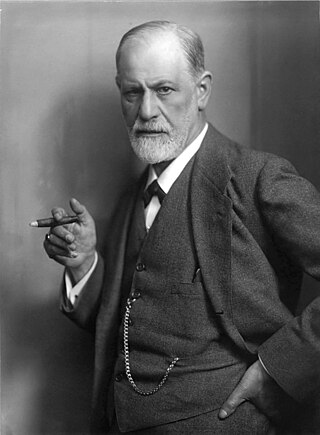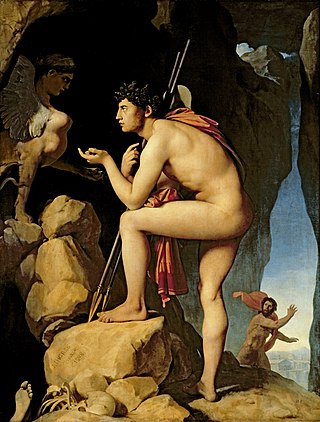Related Research Articles
Psychoanalysis is a set of theories and therapeutic techniques that deal in part with the unconscious mind, and which together form a method of treatment for mental disorders. The discipline was established in the early 1890s by Sigmund Freud, whose work stemmed partly from the clinical work of Josef Breuer and others. Freud developed and refined the theory and practice of psychoanalysis until his death in 1939. In an encyclopedic article, he identified the cornerstones of psychoanalysis as "the assumption that there are unconscious mental processes, the recognition of the theory of repression and resistance, the appreciation of the importance of sexuality and of the Oedipus complex." Freud's colleagues Alfred Adler and Carl Gustav Jung developed offshoots of psychoanalysis which they called individual psychology (Adler) and analytical psychology (Jung), although Freud himself wrote a number of criticisms of them and emphatically denied that they were forms of psychoanalysis. Psychoanalysis was later developed in different directions by neo-Freudian thinkers, such as Erich Fromm, Karen Horney, and Harry Stack Sullivan.
Personality psychology is a branch of psychology that examines personality and its variation among individuals. It aims to show how people are individually different due to psychological forces. Its areas of focus include:
Psychoanalytic theory is the theory of personality organization and the dynamics of personality development relating to the practice of psychoanalysis, a clinical method for treating psychopathology. First laid out by Sigmund Freud in the late 19th century, psychoanalytic theory has undergone many refinements since his work. The psychoanalytic theory came to full prominence in the last third of the twentieth century as part of the flow of critical discourse regarding psychological treatments after the 1960s, long after Freud's death in 1939. Freud had ceased his analysis of the brain and his physiological studies and shifted his focus to the study of the psyche, and on treatment using free association and the phenomena of transference. His study emphasized the recognition of childhood events that could influence the mental functioning of adults. His examination of the genetic and then the developmental aspects gave the psychoanalytic theory its characteristics. Starting with his publication of The Interpretation of Dreams in 1899, his theories began to gain prominence.
An anal retentive person is a person who pays such attention to detail that it becomes an obsession and may be an annoyance to others. The term derives from psychoanalysis techniques employed by Sigmund Freud.

In Freudian psychoanalysis, the term oral stage or hemitaxia denotes the first psychosexual development stage wherein the mouth of the infant is their primary erogenous zone. Spanning the life period from birth to the age of 18 months, the oral stage is the first of the five Freudian psychosexual development stages: (i) the oral, (ii) the anal, (iii) the phallic, (iv) the latent, and (v) the genital.
Castration anxiety is an overwhelming fear of damage to, or loss of, the penis—a derivative of Sigmund Freud's theory of the castration complex, one of his earliest psychoanalytic theories. The term refers to the fear of emasculation in both a literal and metaphorical sense.
Mother's boy, also commonly and informally mummy's boy or mama's boy, is a derogatory term for a man seen as having an unhealthy dependence on his mother at an age at which he is expected to be self-reliant. Use of this phrase is first attested in 1901. The term mama's boy has a connotation of effeminacy and weakness. The counter term, for women, would be a father complex.
The genital stage in psychoanalysis is the term used by Sigmund Freud to describe the final stage of human psychosexual development. The individual develops a strong sexual interest in people outside of the family.

In Freudian psychoanalysis, the phallic stage is the third stage of psychosexual development, spanning the ages of three to six years, wherein the infant's libido (desire) centers upon their genitalia as the erogenous zone. When children become aware of their bodies, the bodies of other children, and the bodies of their parents, they gratify physical curiosity by undressing and exploring each other and their genitals, the center of the phallic stage, in the course of which they learn the physical differences between the male and female sexes and their associated social roles, experiences which alter the psychologic dynamics of the parent and child relationship. The phallic stage is the third of five Freudian psychosexual development stages: (i) the oral, (ii) the anal, (iii) the phallic, (iv) the latent, and (v) the genital.
In Freudian Ego psychology, psychosexual development is a central element of the psychoanalytic sexual drive theory. Freud believed that personality developed through a series of childhood stages in which pleasure seeking energies from the child became focused on certain erogenous areas. An erogenous zone is characterized as an area of the body that is particularly sensitive to stimulation. The five psychosexual stages are the oral, the anal, the phallic, the latent, and the genital. The erogenous zone associated with each stage serves as a source of pleasure. Being unsatisfied at any particular stage can result in fixation. On the other hand, being satisfied can result in a healthy personality. Sigmund Freud proposed that if the child experienced frustration at any of the psychosexual developmental stages, they would experience anxiety that would persist into adulthood as a neurosis, a functional mental disorder.
The anal stage is the second stage in Sigmund Freud's theory of psychosexual development, taking place approximately between the ages 18 months and three years. According to Freud, the anus is the primary erogenous zone and pleasure is derived from controlling bladder and bowel movement. The major conflict issue during this stage is toilet training. A fixation at this stage can result in a personality that is too rigid or one that is too disordered.
Ego psychology is a school of psychoanalysis rooted in Sigmund Freud's structural id-ego-superego model of the mind.
Anal expulsiveness is a theorized state of a person who exhibits cruelty, emotional outbursts, disorganization, self-confidence, artistic ability, generosity, rebelliousness and general carelessness.

An ink blot test is a personality test that involves the evaluation of a subject's response to ambiguous ink blots. This test was published in 1921 by Swiss psychiatrist Hermann Rorschach. The interpretation of people's responses to the Rorschach Inkblot Test was originally based on psychoanalytical theory but investigators have used it in an empirical fashion. When this test is used empirically, the quality of the responses is related to the measurements of personality.
The latency stage is the fourth stage of Sigmund Freud's model of a child's psychosexual development. Freud believed that the child discharges their libido through a distinct body area that characterizes each stage.

In neo-Freudian psychology, the Electra complex, as proposed by Swiss psychiatrist and psychoanalyst Carl Jung in his Theory of Psychoanalysis, is a girl's psychosexual competition with her mother for possession of her father. In the course of her psychosexual development, the complex is the girl's phallic stage; a boy's analogous experience is the Oedipus complex. The Electra complex occurs in the third—phallic stage —of five psychosexual development stages: the oral, the anal, the phallic, the latent, and the genital—in which the source of libido pleasure is in a different erogenous zone of the infant's body.

In classical psychoanalytic theory, the Oedipus complex refers to a son's sexual attitude towards his mother and concomitant hostility toward his father, first formed during the phallic stage of psychosexual development. A daughter's attitude of desire for her father and hostility toward her mother is referred to as the feminine Oedipus complex. The general concept was considered by Sigmund Freud in The Interpretation of Dreams (1899), although the term itself was introduced in his paper A Special Type of Choice of Object made by Men (1910).
Penis envy is a stage in Sigmund Freud's theory of female psychosexual development, in which young girls experience anxiety upon realization that they do not have a penis. Freud considered this realization a defining moment in a series of transitions toward a mature female sexuality. In Freudian theory, the penis envy stage begins the transition from attachment to the mother to competition with the mother for the attention and affection of the father. The young boy's realization that women do not have a penis is thought to result in castration anxiety.
Phallic monism is a term introduced by Chasseguet-Smirgel to refer to the theory that in both sexes the male organ—i.e. the question of possessing the penis or not—was the key to psychosexual development.

Sigmund Freud is considered to be the founder of the psychodynamic approach to psychology, which looks to unconscious drives to explain human behavior. Freud believed that the mind is responsible for both conscious and unconscious decisions that it makes on the basis of psychological drives. The id, ego, and super-ego are three aspects of the mind Freud believed to comprise a person's personality. Freud believed people are "simply actors in the drama of [their] own minds, pushed by desire, pulled by coincidence. Underneath the surface, our personalities represent the power struggle going on deep within us".
References
- 1 2 Taulbee, Earl S. (1968). "The Blacky Pictures Test: A Comprehensive Annotated and Indexed Bibliography (1949–1967)". Journal of Projective Techniques and Personality Assessment. 32 (2): 105–137. doi:10.1080/0091651X.1968.10120461. PMID 4872360.
- ↑ "Gerald S. Blum". University of Michigan. 2011. Archived from the original on 18 January 2018. Retrieved 9 February 2013.
- 1 2 3 4 5 6 7 8 9 Nye, R.D. (1986). Three psychologies: Perspectives from Freud, Skinner, and Rogers. Belmont, CA: Wadsworth, Inc.
- 1 2 Fancher, R. E, & Rutherford, A. (2012). A history: Pioneers of psychology. New York, NY: W.W. Norton & Company.
- 1 2 3 4 5 6 7 Blum, G. S.; Hunt, H. F. (1952). "The validity of the blacky pictures". Psychological Bulletin . 49 (3): 238–250. doi:10.1037/h0057240. PMID 14930160.
- 1 2 3 Blum, G. S., & Kaufman, J. B. (1952). "Two patterns of personality dynamics in male peptic ulcer patients as suggested by responses to the Blacky Pictures". Journal of Clinical Psychology , 8(3), 273-278.
- 1 2 3 Bernstien, L.; Chase, P.H. (1955). "The discriminative ability of the blacky pictures with ulcer patients". Journal of Consulting Psychology. 19 (5): 377–380. doi:10.1037/h0041566. PMID 13263468.
- 1 2 Beck, S (1956). "The Blacky Pictures". Journal of Consulting Psychology. 20 (6): 487–488. doi:10.1037/h0039381.
- 1 2 Eysenck, H. (1990). Decline and fall of the Freudian empire. Washington, D.C.: Scott-Townsend Publishers.